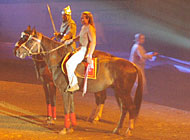Equestrian ballet tells story of Russia’s past

Russian history has been shaped by the horse, and this week the story of a nation is being told in an equestrian ballet in Bern.
The “Plaisirs Russes”, which runs until Sunday at Bern’s annual Bea Expo, tells the story of Russian history from the early barbarian invasions through the reign of Catherine the Great (1729 – 96) to the expulsion of Napoleon.
Horses take centre stage, prancing around the arena in a carefully choreographed “ballet” to music by the likes of Stravinsky and Katchaturian. The programme includes a tableau of singers and dancers – including ballerinas and Cossack folk artists.
One of the highlights is the “troika” – a traditional Russian carriage drawn by three horses. The carriage used in the show once belonged to a well-to-do St Petersburg family.
“Horse country”
The man behind the Plaisirs Russes, Sergey Alexeev, told swissinfo that the show gave audiences an idea of how important horses were shaping the history of Russia. “Russia is ‘horse country’ – our national symbol is the horse.”
He said Russia is today home to some two million horses as well as several equine races, including the white-grey Orlovsky-Rusak breed, named after one of Catherine’s favourite companions, Alexei Orlov.
Catherine’s well-known love of horses was shared by the hussars – mounted Russian soldiers – whose equestrian skills and soulful ballads tell the story of how Napoleon was forced from Russia after his disastrous march on Moscow.
The grand finale comes with the Cossacks and their wild folk dances. These hard drinking fighters, whose influence was destroyed by the revolution, were legendary for their horsemanship and were said to have been born in the saddle.
The show runs until Sunday at the Bea Expo in Bern. Visitors can also take in an exhibition dedicated to St Petersburg, which celebrates its 300th anniversary next year.
It includes paintings and bronze sculptures by Russian artists, clothing, and traditional handicrafts including lacquered dolls and eggs.
By MaryAnn Mathew

In compliance with the JTI standards
More: SWI swissinfo.ch certified by the Journalism Trust Initiative
You can find an overview of ongoing debates with our journalists here. Please join us!
If you want to start a conversation about a topic raised in this article or want to report factual errors, email us at english@swissinfo.ch.